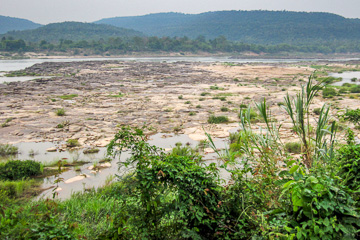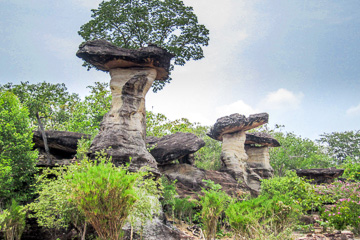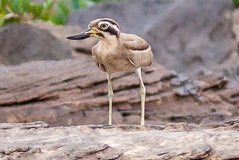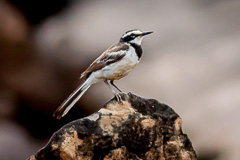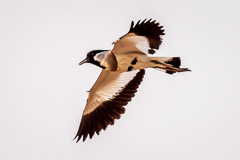Overview
Tucked away in the remote east, the area along the Mekong River adjacent to Pha Teem National Park is a key locality for finding the highly range-restricted Mekong Wagtail, with the added attraction of Great Stone-curlew and River Lapwing. The predominant natural habitat remaining is open, dry Dipterocarp forest that forms an outpost of several species restricted to the habitat in Thailand, such as White-rumped Falcon. As this area is rarely visited by birders, the status of species is not well monitored nor understood, and winter migrants along the Mekong are potentially of special interest. An inordinate amount of mosquitos seem to be present, even in the dry season. Information on this page verified/accurate as of 26 Mar 2016.
|
AccessAnyone on a short trip is unlikely to have the time required to visit this remote area of extreme eastern Thailand. The driving distance from Bangkok and Chiang Mai are in the region of 700 and 1,000 kilometres respectively, with many stretches of highway only single carriageway, that makes for slow going. Those looking to save some time might consider flying from Bangkok to Ubon Ratchathani and renting a vehicle from there. From Ubon Ratchathani head eastward, picking up Highway 2222 and then Highway 2112 signposted to Khemmarat. Take Highway 2112 northward, parallel to the Mekong, following signs to Pha Taem National Park. At the intersection with Highway 2368 zero the tripmeter and turn east. After 1.4 kilometres turn right, signposted to Had Wijitra which is reached at 7.4 kilometres. Pha Taem National Park, most known for its geological rock formations and prehistoric cave paintings, has two principle access points. The southerly, to the park HQ and Nature Trail, is reached turning off Highway 2112 and proceeding 2.4 kilometres to the park entrance. The more northerly area, around Soi Sawan Waterfall, is found by continuing 12.6 kilometres northward and turning right as far as 16.5 kilometres to arrive at the entrance. Tickets purchased at either access point are valid for both areas.
|
Accommodation and Facilities
Although this area is decidedly rural, its adjacency to the Mekong has resulted in a few resorts having sprung up along the river, located between Kaeng Pisa Mai and Had Wijitra. Other than these resorts the only facilities are a few local shops and very simple restaurants - none of which can be expected to be open after dark. For those wishing to take a boat along the river, try contacting one of the resorts.
Birding
For the Mekong specialities it's most prudent to visit in the dry season from December to April when the river level should be low, such that access to the exposed rocks is easier. Note also that this region is famous for the, as yet unexplained, Naga Fireballs, that attract a large number of visitors - often in their thousands, around the end of Buddhist Lent, usually late October.
Although this in itself might be interesting, the disturbance to the area would certainly make finding the river birds more difficult. Mekong at Had Wijitra Once past the village of Ban Kum, the road runs more or less along the Mekong for about five kilometres, with views possible in several spots, most notably at Kaeng Pisa Mai and a roadside shelter just past Had Wijitra. Whilst viewing from these spots may possibly afford views of any of the sought after species, they will be distant and unsatisfactory. So the best approach will be to walk down the bank and access the rocks in the river. This is not as easy as it might sound, as the bank is often steep, heavily overgrown, and channels in the river can block access. There are good rocks out from Kaeng Pisa Mai, down river west of Ban Kum, and a little west of Ban Ta Mui. Ease of access will depend on time of year, but when the water is low it's possible to access directly from Kaeng Pisa Mai and also by walking north from Had Wijitra a kilometre or so. In March 2016 a huge rock bank was under construction - part of the canalisation of the Mekong - at Ban Ta Mui, with much bank destruction, noise and disturbance. All the specialities occur in the same areas and habitat, so it's just a question of walking and scanning. In addition to Mekong Wagtail, Great Stone-curlew and River Lapwing, Wire-tailed Swallow can be found, although the stone-curlew is partially nocturnal. Pha Taem National Park Driving around, and stopping anywhere in the park is probably as good a strategy than anything else. Little is know about birding here, but the open forested habitat can be explored. At the southern side of the park, follow the entrance road as far as the Sao Chaliang rock formation, starting from which is a nature trail that winds through low forest and bamboo. To the north, the area around Soi Sawan Waterfall looks interesting, with slightly denser and taller forest than to the south. In addition to the waterfall, the area has several wild flower fields worthy of a visit at the beginning of the monsoon. From the carpark at the falls a trail runs several kilometres to a viewpoint, high on the cliffs, overlooking the Mekong. |
|
Checklist
Checklist of species.
Gallery
Additional images from Pha Team and Had Wijitra available in the Thailand Travel gallery.
Sunrise and Sunset
Detailed sunrise and sunset times.

